2023 FORD SUPER DUTY seats
[x] Cancel search: seatsPage 5 of 738

Contacting Us
Contacting Us..................................................19
Introduction
About This Publication.................................21
Using This Publication.................................22
Symbols Glossary
Symbols Used on Your Vehicle................23
Data Privacy
Data Privacy....................................................26
Service Data.....................................................27
Event Data........................................................27
Settings Data..................................................28
Connected Vehicle Data.............................28
Mobile Device Data.......................................29
Emergency Call System Data...................29
Environment
Protecting the Environment.....................30
Visual Search
Steering Wheel................................................31
Instrument Panel...........................................32
Vehicle Interior................................................33
Front Exterior..................................................34
Rear Exterior....................................................35
Child Safety
Child Safety Precautions............................36
Child Restraint Anchor Points...................37
Child Restraints..............................................39
Installing Child Restraints..........................40
Booster Seats.................................................47
Child Safety Locks - Crew Cab/SuperCab.....................................................49
Seatbelts
Seatbelt Precautions...................................50
Fastening and Unfastening the Seatbelts............................................................................51
Sensitive Locking Mode..............................52
Automatic Locking Mode...........................52
Adjusting the Seatbelts DuringPregnancy....................................................53
Adjusting the Seatbelt Height..................53
Adjusting the Seatbelt Length.................54
Seatbelt Reminder.......................................54
Checking the Seatbelts..............................56
Seatbelt Extensions.....................................56
Airbags
How Do the Front Airbags Work..............57
How Do the Side Airbags Work................57
How Does the Safety Canopy™ Work..........................................................................58
Airbag Precautions.......................................59
Switching the Passenger Airbag On andOff..................................................................60
Properly Adjusting the Driver and FrontPassenger Seats.......................................64
Children and Airbags...................................64
Crash Sensors and Airbag Indicator......65
Disposing of Airbags....................................66
911 Assist
What Is 911 Assist..........................................67
How Does 911 Assist Work.........................67
Emergency Call Requirements.................67
Emergency Call Limitations......................68
911 Assist Videos...........................................68
Keys and Remote Controls
Remote Control Limitations.....................69
Using the Remote Control.........................69
Using the Key Cards.....................................69
Using Digital Key.............................................71
1
2023 Super Duty (TFH) Canada/United States of America, enUSA, Edition date: 202211, DOMTable of Contents
Page 9 of 738
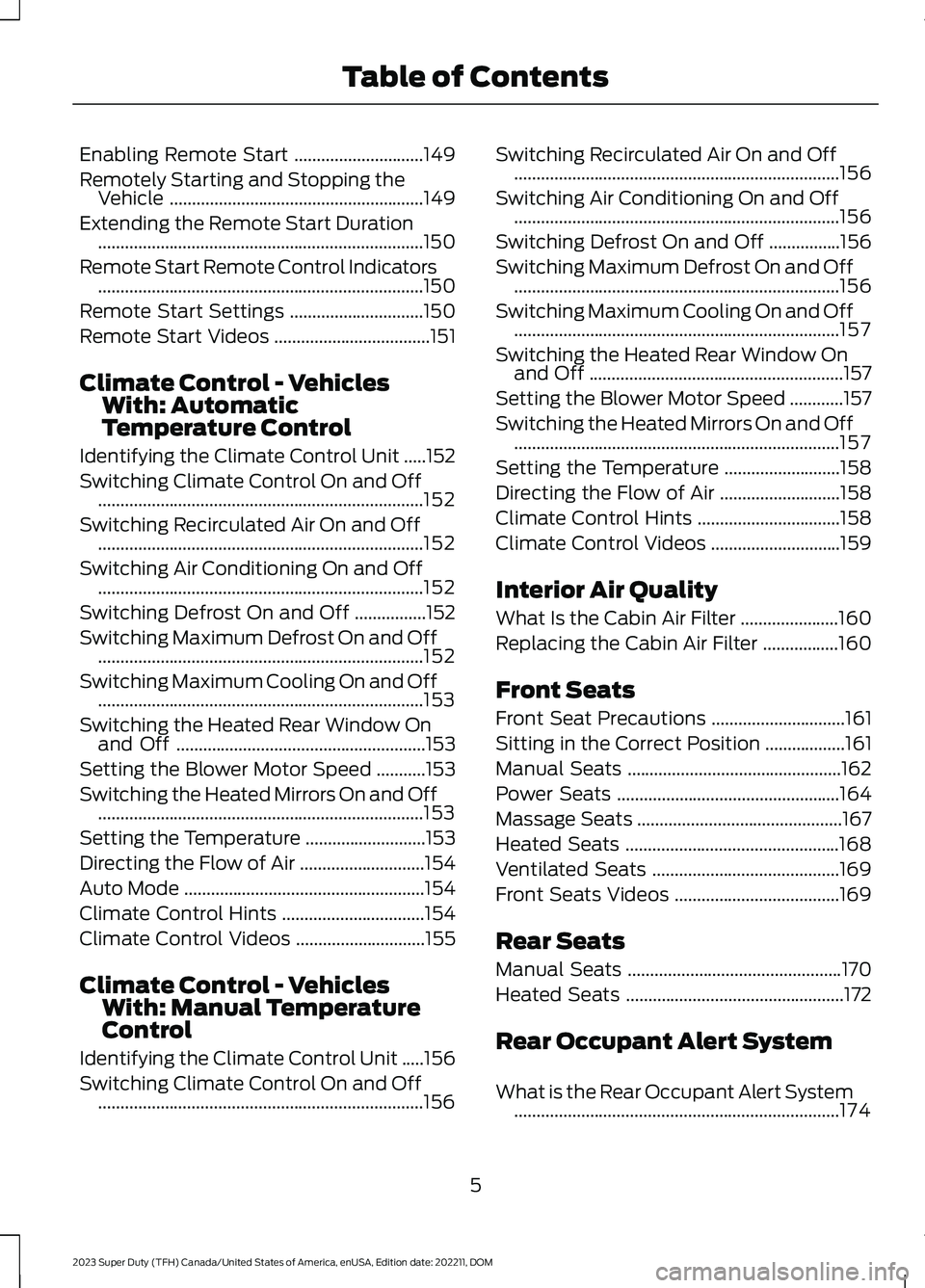
Enabling Remote Start.............................149
Remotely Starting and Stopping theVehicle.........................................................149
Extending the Remote Start Duration.........................................................................150
Remote Start Remote Control Indicators.........................................................................150
Remote Start Settings..............................150
Remote Start Videos...................................151
Climate Control - VehiclesWith: AutomaticTemperature Control
Identifying the Climate Control Unit.....152
Switching Climate Control On and Off.........................................................................152
Switching Recirculated Air On and Off.........................................................................152
Switching Air Conditioning On and Off.........................................................................152
Switching Defrost On and Off................152
Switching Maximum Defrost On and Off.........................................................................152
Switching Maximum Cooling On and Off.........................................................................153
Switching the Heated Rear Window Onand Off........................................................153
Setting the Blower Motor Speed...........153
Switching the Heated Mirrors On and Off.........................................................................153
Setting the Temperature...........................153
Directing the Flow of Air............................154
Auto Mode......................................................154
Climate Control Hints................................154
Climate Control Videos.............................155
Climate Control - VehiclesWith: Manual TemperatureControl
Identifying the Climate Control Unit.....156
Switching Climate Control On and Off.........................................................................156
Switching Recirculated Air On and Off.........................................................................156
Switching Air Conditioning On and Off.........................................................................156
Switching Defrost On and Off................156
Switching Maximum Defrost On and Off.........................................................................156
Switching Maximum Cooling On and Off.........................................................................157
Switching the Heated Rear Window Onand Off.........................................................157
Setting the Blower Motor Speed............157
Switching the Heated Mirrors On and Off.........................................................................157
Setting the Temperature..........................158
Directing the Flow of Air...........................158
Climate Control Hints................................158
Climate Control Videos.............................159
Interior Air Quality
What Is the Cabin Air Filter......................160
Replacing the Cabin Air Filter.................160
Front Seats
Front Seat Precautions..............................161
Sitting in the Correct Position..................161
Manual Seats................................................162
Power Seats..................................................164
Massage Seats..............................................167
Heated Seats................................................168
Ventilated Seats..........................................169
Front Seats Videos.....................................169
Rear Seats
Manual Seats................................................170
Heated Seats.................................................172
Rear Occupant Alert System
What is the Rear Occupant Alert System.........................................................................174
5
2023 Super Duty (TFH) Canada/United States of America, enUSA, Edition date: 202211, DOMTable of Contents
Page 37 of 738
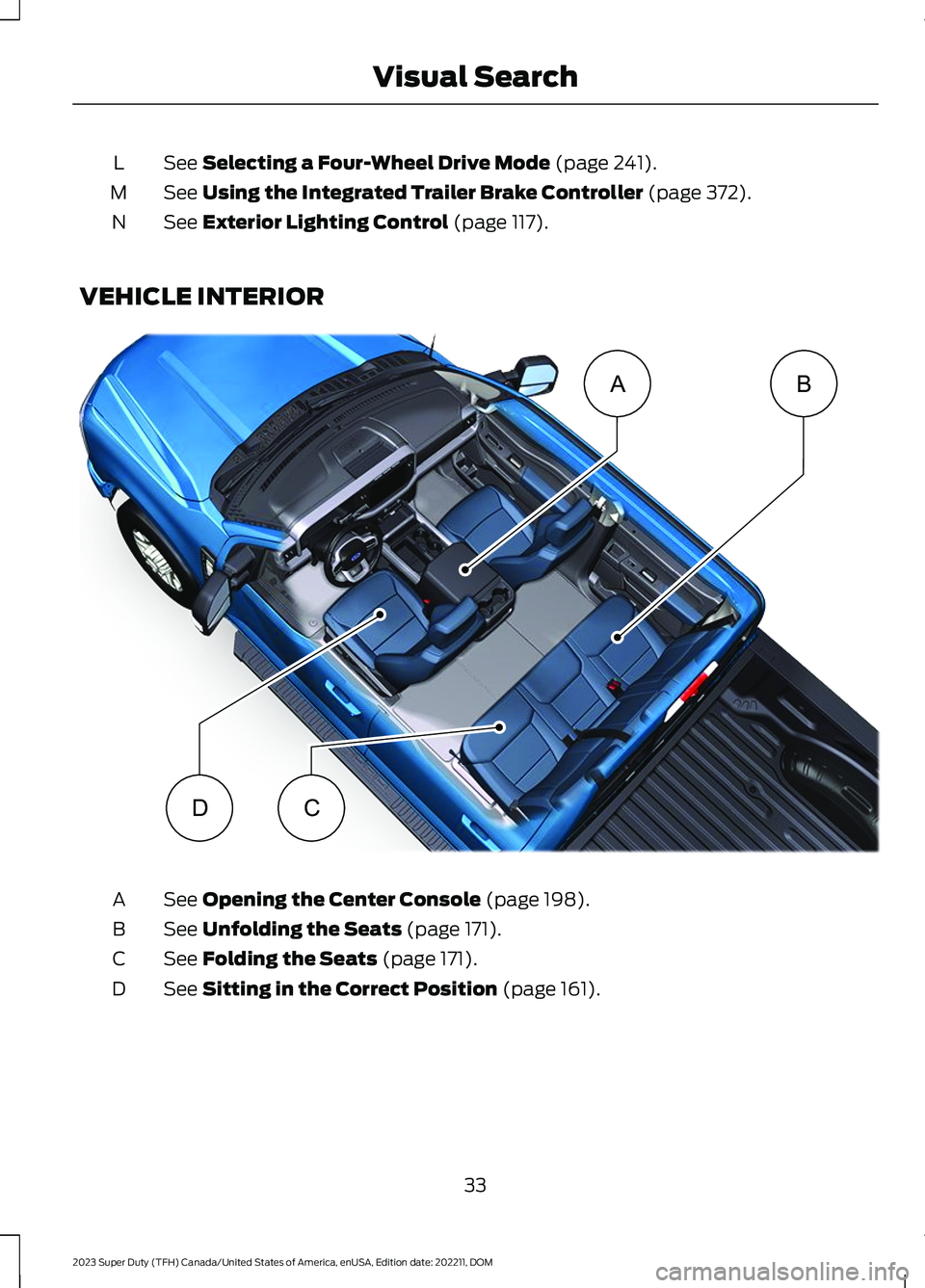
See Selecting a Four-Wheel Drive Mode (page 241).L
See Using the Integrated Trailer Brake Controller (page 372).M
See Exterior Lighting Control (page 117).N
VEHICLE INTERIOR
See Opening the Center Console (page 198).A
See Unfolding the Seats (page 171).B
See Folding the Seats (page 171).C
See Sitting in the Correct Position (page 161).D
33
2023 Super Duty (TFH) Canada/United States of America, enUSA, Edition date: 202211, DOMVisual SearchBADC E374896
Page 41 of 738
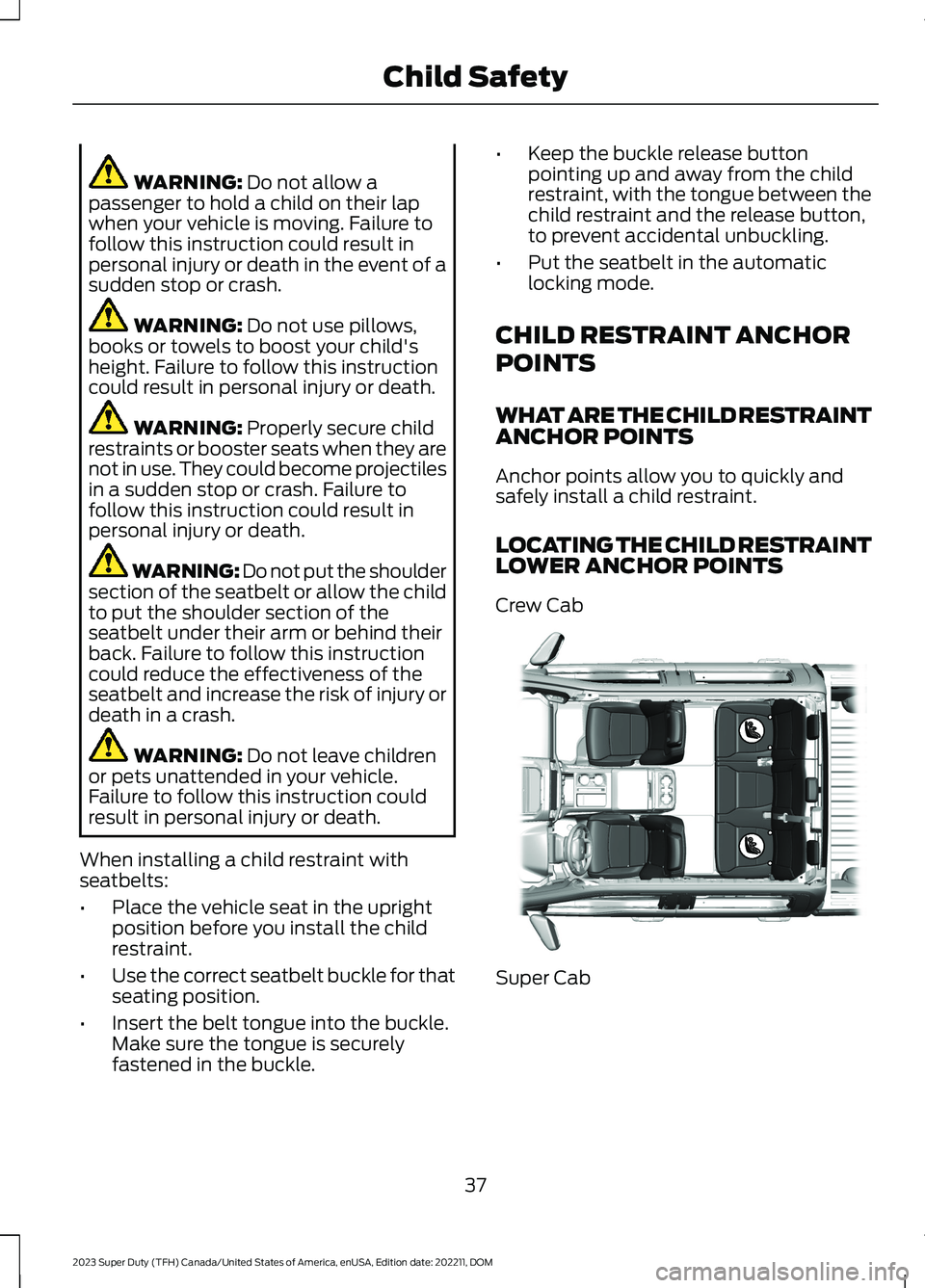
WARNING: Do not allow apassenger to hold a child on their lapwhen your vehicle is moving. Failure tofollow this instruction could result inpersonal injury or death in the event of asudden stop or crash.
WARNING: Do not use pillows,books or towels to boost your child'sheight. Failure to follow this instructioncould result in personal injury or death.
WARNING: Properly secure childrestraints or booster seats when they arenot in use. They could become projectilesin a sudden stop or crash. Failure tofollow this instruction could result inpersonal injury or death.
WARNING: Do not put the shouldersection of the seatbelt or allow the childto put the shoulder section of theseatbelt under their arm or behind theirback. Failure to follow this instructioncould reduce the effectiveness of theseatbelt and increase the risk of injury ordeath in a crash.
WARNING: Do not leave childrenor pets unattended in your vehicle.Failure to follow this instruction couldresult in personal injury or death.
When installing a child restraint withseatbelts:
•Place the vehicle seat in the uprightposition before you install the childrestraint.
•Use the correct seatbelt buckle for thatseating position.
•Insert the belt tongue into the buckle.Make sure the tongue is securelyfastened in the buckle.
•Keep the buckle release buttonpointing up and away from the childrestraint, with the tongue between thechild restraint and the release button,to prevent accidental unbuckling.
•Put the seatbelt in the automaticlocking mode.
CHILD RESTRAINT ANCHOR
POINTS
WHAT ARE THE CHILD RESTRAINTANCHOR POINTS
Anchor points allow you to quickly andsafely install a child restraint.
LOCATING THE CHILD RESTRAINTLOWER ANCHOR POINTS
Crew Cab
Super Cab
37
2023 Super Duty (TFH) Canada/United States of America, enUSA, Edition date: 202211, DOMChild SafetyE308373
Page 44 of 738

CHILD RESTRAINTS RECOMMENDATION
Recommended Restraint TypeChild Size, Height, Weight, or Age
Use a child restraint (sometimescalled an infant carrier, convertibleseat, or toddler seat).
Children weighing 40 lb (18 kg) or less (generallyage four or younger).
Use a belt-positioning boosterseat.
Children who have outgrown or no longer properlyfit in a child restraint (generally children who areless than 57 in (1.45 m) tall, are greater than agefour and less than age 12, and between 40 lb (18 kg)and 80 lb (36 kg) and upward to 100 lb (45 kg) ifrecommended by your child restraint manufacturer).
Use a vehicle seatbelt having thelap belt snug and low across thehips, shoulder belt centered acrossthe shoulder and chest, and seatbackrest upright.
Children who have outgrown or no longer properlyfit in a belt-positioning booster seat (generally chil-dren who are at least 57 in (1.45 m) tall or greaterthan 80 lb (36 kg) or 100 lb (45 kg) if recommendedby child restraint manufacturer).
You are required by law to properly usechild restraints for infants and toddlers inthe United States, Canada and Mexico.
Many states and provinces require thatsmall children use approved booster seatsuntil they reach age eight, a height of 57 in(1.45 m) tall, or 80 lb (36 kg). Check yourlocal and state or provincial laws forspecific requirements about the safety ofchildren in your vehicle.
When possible, properly restrain children12 years of age and under in a rear seatingposition of your vehicle. Accident statisticssuggest that children are safer whenproperly restrained in the rear seatingpositions than in a front seating position.
When installing a rear facing child restraint,adjust the vehicle seats to avoidinterference between the child restraintand the vehicle seat in front of the childrestraint.
INSTALLING CHILD
RESTRAINTS
USING SEATBELTS
WARNING: Depending on whereyou secure a child restraint, anddepending on the child restraint design,you may block access to certain seatbeltbuckle assemblies and LATCH loweranchors, rendering those featurespotentially unusable. To avoid risk ofinjury, make sure occupants only useseating positions where they are able tobe properly restrained.
Note:The following does not apply to thefront center position of Super Cab and CrewCab vehicles.
Note:Although the child restraintillustrated is a forward facing child restraint,the steps are the same for installing a rearfacing child restraint.
40
2023 Super Duty (TFH) Canada/United States of America, enUSA, Edition date: 202211, DOMChild Safety
Page 45 of 738
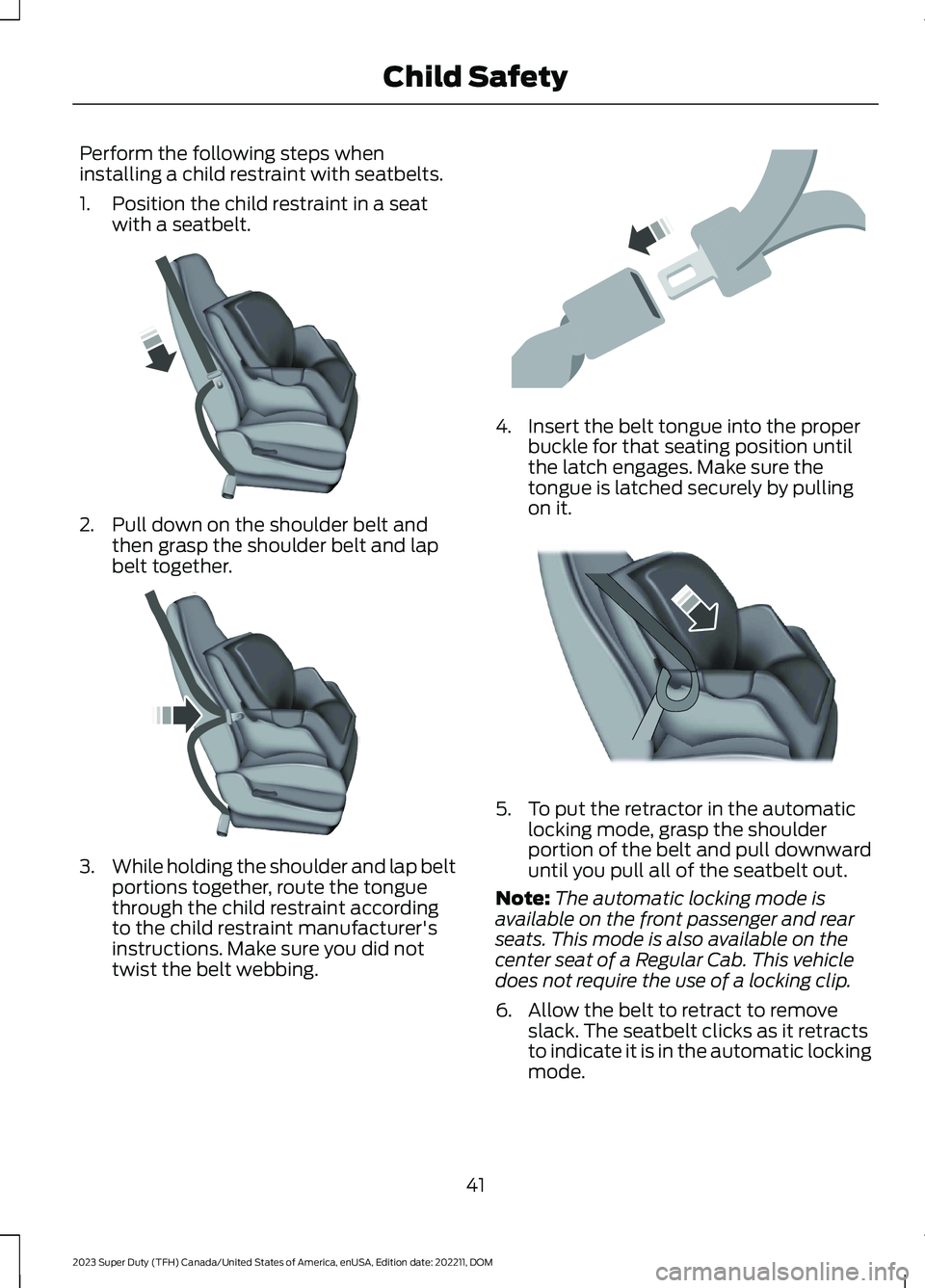
Perform the following steps wheninstalling a child restraint with seatbelts.
1.Position the child restraint in a seatwith a seatbelt.
2.Pull down on the shoulder belt andthen grasp the shoulder belt and lapbelt together.
3.While holding the shoulder and lap beltportions together, route the tonguethrough the child restraint accordingto the child restraint manufacturer'sinstructions. Make sure you did nottwist the belt webbing.
4.Insert the belt tongue into the properbuckle for that seating position untilthe latch engages. Make sure thetongue is latched securely by pullingon it.
5.To put the retractor in the automaticlocking mode, grasp the shoulderportion of the belt and pull downwarduntil you pull all of the seatbelt out.
Note:The automatic locking mode isavailable on the front passenger and rearseats. This mode is also available on thecenter seat of a Regular Cab. This vehicledoes not require the use of a locking clip.
6.Allow the belt to retract to removeslack. The seatbelt clicks as it retractsto indicate it is in the automatic lockingmode.
41
2023 Super Duty (TFH) Canada/United States of America, enUSA, Edition date: 202211, DOMChild SafetyE142529 E142530 E142531 E142875
Page 50 of 738
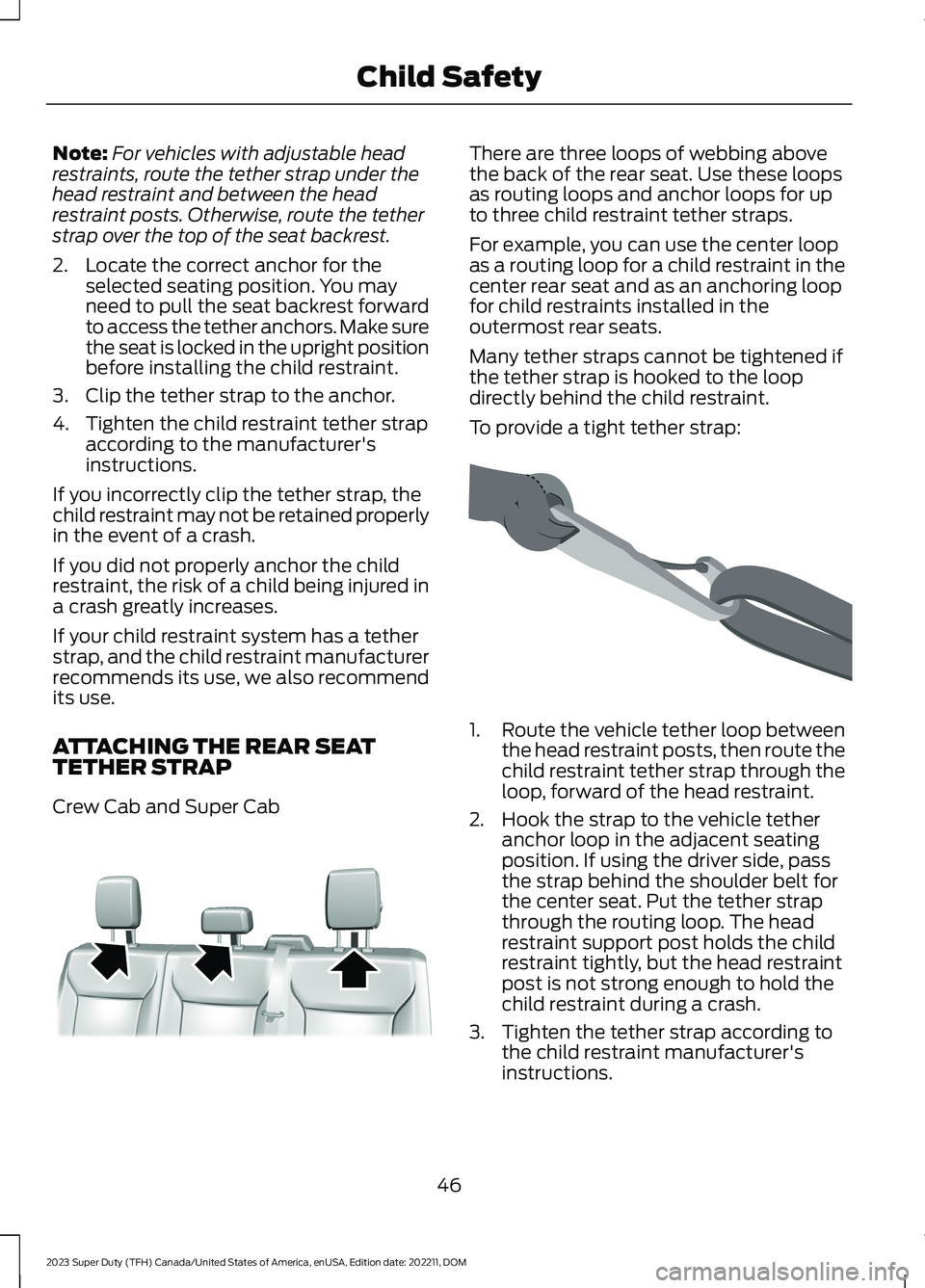
Note:For vehicles with adjustable headrestraints, route the tether strap under thehead restraint and between the headrestraint posts. Otherwise, route the tetherstrap over the top of the seat backrest.
2.Locate the correct anchor for theselected seating position. You mayneed to pull the seat backrest forwardto access the tether anchors. Make surethe seat is locked in the upright positionbefore installing the child restraint.
3.Clip the tether strap to the anchor.
4.Tighten the child restraint tether strapaccording to the manufacturer'sinstructions.
If you incorrectly clip the tether strap, thechild restraint may not be retained properlyin the event of a crash.
If you did not properly anchor the childrestraint, the risk of a child being injured ina crash greatly increases.
If your child restraint system has a tetherstrap, and the child restraint manufacturerrecommends its use, we also recommendits use.
ATTACHING THE REAR SEATTETHER STRAP
Crew Cab and Super Cab
There are three loops of webbing abovethe back of the rear seat. Use these loopsas routing loops and anchor loops for upto three child restraint tether straps.
For example, you can use the center loopas a routing loop for a child restraint in thecenter rear seat and as an anchoring loopfor child restraints installed in theoutermost rear seats.
Many tether straps cannot be tightened ifthe tether strap is hooked to the loopdirectly behind the child restraint.
To provide a tight tether strap:
1.Route the vehicle tether loop betweenthe head restraint posts, then route thechild restraint tether strap through theloop, forward of the head restraint.
2.Hook the strap to the vehicle tetheranchor loop in the adjacent seatingposition. If using the driver side, passthe strap behind the shoulder belt forthe center seat. Put the tether strapthrough the routing loop. The headrestraint support post holds the childrestraint tightly, but the head restraintpost is not strong enough to hold thechild restraint during a crash.
3.Tighten the tether strap according tothe child restraint manufacturer'sinstructions.
46
2023 Super Duty (TFH) Canada/United States of America, enUSA, Edition date: 202211, DOMChild SafetyE309318 E309384
Page 51 of 738

If you did not properly anchor the childrestraint, the risk of a child being injured ina crash greatly increases.
If your child restraint system has a tetherstrap, and the child restraint manufacturerrecommends its use, we also recommendits use.
BOOSTER SEATS
Use a belt-positioning booster seat forchildren who have outgrown or no longerproperly fit in a child restraint and meetthe following criteria.
•Generally children who are less than57 in (1.45 m) tall.
•Are greater than age four (4) and lessthan age twelve (12).
•Are between 40 lb (18 kg) and 80 lb(36 kg) and upward to 100 lb (45 kg).
Many state and provincial laws require thatchildren use approved booster seats untilthey reach age eight, a height of 57 in(1.45 m) tall, or 80 lb (36 kg).
Booster seats should be used until you cananswer yes to all of these questions whenseated without a booster seat:
•Can the child sit all the way backagainst their vehicle seat backrest withknees bent comfortably at the edge ofthe seat cushion?
•Can the child sit without slouching?
•Does the lap belt rest low across thehips?
•Is the shoulder belt centered on theshoulder and chest?
•Can the child stay seated like this forthe whole trip?
Always use booster seats in conjunctionwith your vehicle lap and shoulder belt.
Types of Booster Seats
•Backless booster seats
If your backless booster seat has aremovable shield, remove the shield.
If a vehicle seating position has a low seatbackrest or no head restraint, a backlessbooster seat may place your child's head,as measured at the tops of the ears, abovethe top of the seat. In this case, move thebackless booster to another seatingposition with a higher seat backrest orhead restraint and lap and shoulder belts,or consider using a high-back booster seat.
47
2023 Super Duty (TFH) Canada/United States of America, enUSA, Edition date: 202211, DOMChild SafetyE142595 E68924